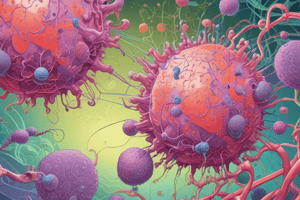Podcast
Questions and Answers
What is the primary role of dendritic cells within the immune system?
What is the primary role of dendritic cells within the immune system?
- To directly kill infected cells
- To transport antigens to lymph nodes
- To produce antibodies against pathogens
- To assist in the activation of T cells (correct)
Where are dendritic cells predominantly found in the body?
Where are dendritic cells predominantly found in the body?
- In the bone marrow
- In the bloodstream
- In lymphoid tissues and connective tissues (correct)
- In muscle tissues
Which of the following is characteristic of dendritic cells?
Which of the following is characteristic of dendritic cells?
- Ability to produce cytokines in large quantities
- Dendritic cytoplasmic processes (correct)
- Presence of class I MHC complexes on their surface
- They do not migrate in response to antigens
What occurs when a peptide fragment of an antigen binds to a T-cell receptor?
What occurs when a peptide fragment of an antigen binds to a T-cell receptor?
In response to antigenic challenges, where do dendritic cells migrate within the pulp?
In response to antigenic challenges, where do dendritic cells migrate within the pulp?
What defines dendritic cells as antigen-presenting cells?
What defines dendritic cells as antigen-presenting cells?
Which cells are dendritic cells similar to in function and morphology? AKA what is its other name?
Which cells are dendritic cells similar to in function and morphology? AKA what is its other name?
Flashcards are hidden until you start studying
Study Notes
Dendritic Cells
- Immune system accessory cells
- Found in lymphoid tissues, connective tissues, and epidermis
- Also called Langerhans cells in the epidermis and mucous membranes
- Antigen-presenting cells
- Characterized by dendritic cytoplasmic processes and class II MHC complexes on their cell surface
- Primarily found in the periphery of coronal pulp, but migrate centrally after antigenic challenge
- Play a central role in the induction of T-cell–dependent immunity
- Engulf protein antigens and present peptide fragments of the antigens and MHC class II molecules
- This assembly is recognized by T cells, binding to their T-cell receptors and activating them.
- Can interact directly with lymphocytes.
Studying That Suits You
Use AI to generate personalized quizzes and flashcards to suit your learning preferences.




